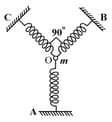Spring Force
Spring Force: Overview
This Topic covers sub-topics such as Spring Forces, Effective Force Constant, Arrangement of Springs, Series Arrangement of Springs, Cutting of Springs in a Ratio, Effect of Cutting of Springs and Strings in System and, Parallel Arrangement of Springs
Important Questions on Spring Force
When, two ends of an ideal spring are pulled apart increasing its length it produces force equal to at its ends. At a point of its length from one end, the force is
Two blocks with mass and respectively are connected by a stretched spring of negligible mass as in figure. When the two blocks are released simultaneously the initial acceleration of is westward. The acceleration of is:

Two springs of force constants (Spring A) and (Spring B) are joined together in series. The combination is compressed by . The ratio of energy stored in and is Then is equal to:
In a molecule, the can be treated on infinite mass and oscillating alone. If the oscillation of molecule shows frequency of the value of force constant is (take Avogadro number
The system shown in the figure is released from rest. Pulley and spring are massless and friction is absent everywhere. The speed of block when block leaves the contact with ground is
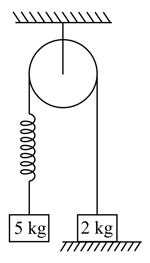
A mass is suspended by two springs of force constants and respectively as shown in the diagram. The total elongation (stretch) of the two springs is

What will be time period of the displaced body of mass ?

A trolley of mass is connected to two identical springs of spring constant as shown in the figure. The trolley is displaced from its equilibrium position by and released. Find the maximum speed of the trolley in the ensuing motion.

A solid cylinder of mass is rolling on a horizontal smooth surface with velocity . It strikes with a fixed horizontal spring of force constant . The maximum compression produced in the spring is
Match the Column I with Column II:
| Column - I | Column - II | ||
|---|---|---|---|
 |
|
||
 |
|||
 |
|||
 |
A trolley of mass , as shown in figure, is connected to two identical springs, each having spring constant equal to . If the trolley is displaced from its equilibrium position by and released, the maximum speed of the trolley is:

In the system shown in figure and pulley and threads are ideal. System is held at rest by thread Just after thread is burnt,
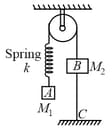
Two springs are connected to a block of mass placed on a frictionless surface as shown below. If both the springs have a spring constant then the frequency of oscillation of the block is

Two identical springs (spring constant = ) are connected to two light rigid rods in parallel combination and then a third spring (identical to the other two) is connected to this combination in series. The combined system is fixed to the ceiling and a block of mass is attached as shown in the figure. If the mass is slightly displaced and then let go, then the system shall oscillate with a time period of
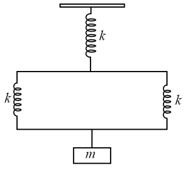
Consider a system of two solid balls connect by a light spring in air which is horizontal at the given instant. The horizontal acceleration of the 10 kg ball is towards right at the given instant. What would be the total acceleration of the 20 kg ball, if it starts falling? (take )

As shown in figure a simple harmonic motion oscillator having identical four springs has time period
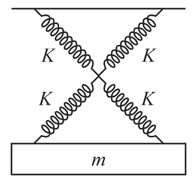
If and respectively are effective spring constant in series and parallel combination of springs as shown in figure, find
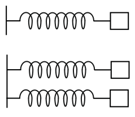
A particle of mass is attached to three identical springs , and each of force constant as shown in figure. If the particle of mass is pushed slightly against the spring and released then the time period of oscillations is
On a smooth inclined plane, a body of mass M is attached between two springs. The other ends of the springs are fixed to firm supports. If each spring has force constant K, the period of oscillation of the body (assuming the springs as massless) is
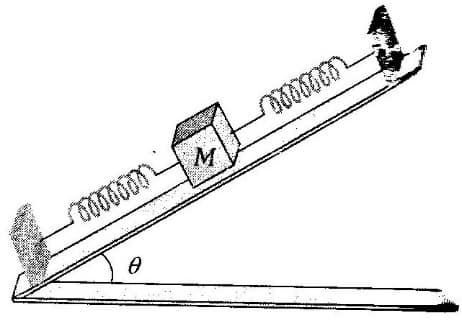
A spring of force constant k is cut into two pieces such that one piece is double the length of the other. Then the long piece will have a force constant of

